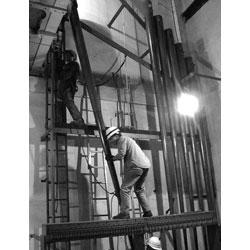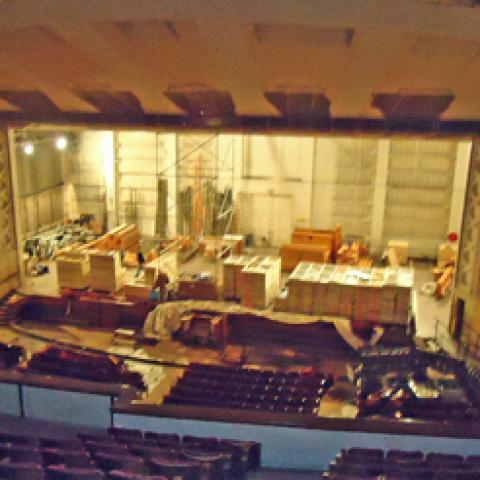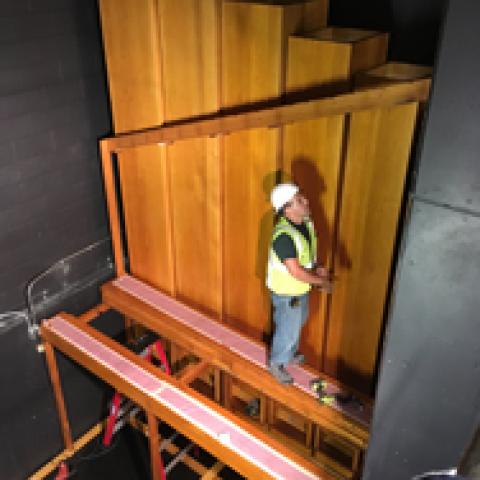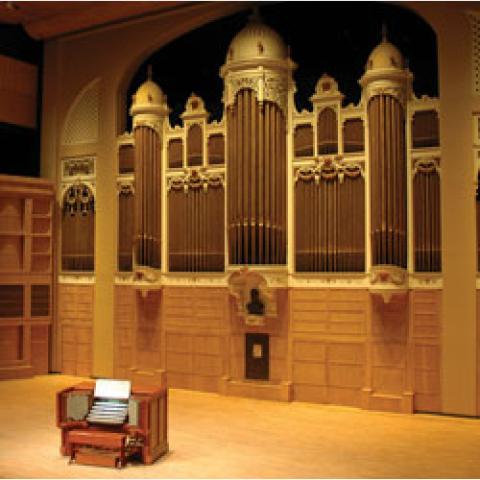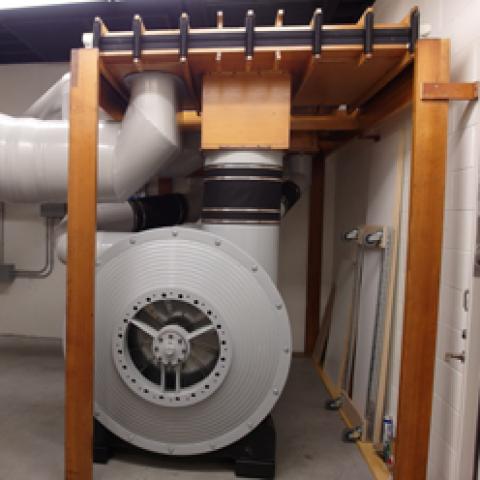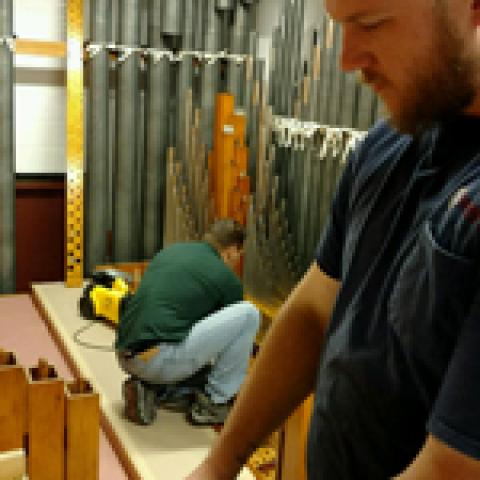Winthrop University began in 1886 in Columbia, South Carolina as the Winthrop Training School, to train women teachers. Robert Winthrop, chair of the Peabody Foundation in Boston, was the philanthropist who made the effort possible, with a generous gift of $1,500, plus a personal check for $50 for books to David Bancroft Johnson, the Columbia Superintendent of Schools, who was the school’s mentor. The state legislature soon found reason to establish a Normal and Industrial School for Women, and in 1895, Rock Hill was the chosen city. Winthrop’s name was retained. Some decades later the name was changed to Winthrop State College for Women. Eventually it became Winthrop College. Men were admitted in 1974, and a few years later the name changed to Winthrop University. Some 6,500 students at bachelor and master degree levels populate the campus today. The Department of Music is in the College of Visual and Performing Arts.
The College Auditorium and Conservatory of Music (the wording engraved in stone high up on the outside façade) were built in 1938–39 with funds from the WPA (Work Projects Administration). For fourteen years the concept of an organ for the College Auditorium (later designated the James F. Byrnes Auditorium) was a dream of the music department head, Dr. Walter B. Roberts. Under Roberts’ guidance, alumni raised $15,000, and the State of South Carolina appropriated $35,000. Ultimately, the 1952 contract with the Aeolian-Skinner Organ Company of Boston, Massachusetts, was for $59,865. Some months later another $3,000 was applied to the contract for the 32′ Contre Basse. The Class of 1914 (which in that fateful year was so penniless that it was unable to leave a class gift) achieved its goal in 1955 by donating $1,400 for the Deagan chime stop. The total of the initial expenditure added up to $64,265.
A 1951 letter from G. Donald Harrison, president and tonal director of the Aeolian-Skinner Organ Company, thanks Dr. Roberts for the invitation to design an organ for Winthrop, but Harrison goes on to say:
. . . as the college is a state school, bids will be necessary. I feel that in view of this it would be useless for us to put in a bid as we are bound to be the highest bidder with absolutely no chance of landing the contract.
President Sims just a week later, July 17, responded that
. . . the determination of which organ offered the most for the price could not be made on a mere dollar basis . . . I cannot guarantee that the committee will eventually select the organ you submit, still I do want you to feel that any proposal you make will receive careful consideration . . .
A month later, Harrison sent a specification of the proposed instrument and a justification of the tonal design that reflects the philosophy now known as “American Classic.”
Fifteen or more years ago, I developed a type of organ which combined both Classical and Romantic material in one instrument, the sole idea being to produce an organ that was capable of giving authentic renditions of all types of worthwhile organ music and an instrument that would suit players such as Virgil Fox, on the one hand, and Professor Fritz Heitmann at the Berlin Dom, on the other.
Harrison himself was in the auditorium in August 1955 for the final voicing of the organ. It was ten months later that Harrison died in his apartment in New York City, while finishing the rebuilding of the E. M. Skinner organ (Opus 205A) in St. Thomas Church, Fifth Avenue.
Today the D. B. Johnson Memorial organ stands as one of the few Aeolian-Skinner organs with Harrison’s signature that is not a rebuild of a previous instrument. It reflects Harrison’s 1950s concept of what his American Classic sound should be, and he obviously took advantage of calculating his design for the 3,500-seat space, which boasts a two-second reverberation time. Virgil Fox played the inaugural recitals November 2 and 3, 1955.
For the first ten years after the installation, the college organists (a title no longer used) were Jeannette Roth, Wilbur Sheridan, Wilmer Hayden Welsh, and George Klump. David M. Lowry became college organist in 1965. Lowry became professor emeritus in 1996, and has remained the part-time organ professor since. Many undergraduate and graduate students have performed their degree recitals on the Byrnes Auditorium organ. Lowry has been heard in nearly 100 performances—solo recitals, lecture-recitals, ensemble concerts, symphony orchestra programs, and the annual Festival of Carols.
The roster of guest artists on the organ is remarkable, due greatly to the support of Dr. Roberts for its first few years, then with the continued support of Dr. Jess T. Casey for over thirty years. That list includes Marie-Claire Alain, Robert Anderson, Robert Baker, David Craighead, Catharine Crozier, Virgil Fox, Fernando Germani, Jerald Hamilton, Yuko Hayashi, Anton Heiller, Paul Jenkins, Wilma Jensen, Marilyn Keiser, Jean Langlais, Simon Preston, Alexander Schreiner, Larry Smith, Murray Somerville, John Chappell Stowe, and many others.
As with the purchase of the instrument, the search for a builder to restore the instrument fell into a category of specialized work where the low bid did not have to be the winner. A panel of judges read the proposals, and the voting for the winner was under the supervision of a state agent. Létourneau Pipe Organs of Saint-Hyacinthe, Québec won the contract. In 1967, Fernand Létourneau, at just 23 years of age, was present in Rock Hill installing an organ for another firm when Marie-Claire Alain played a recital in Byrnes Auditorium. Following the concert, he came to a private party for her and engaged her in conversation about Dom Bédos de Celles. It was a significant moment in his life that he has never forgotten, and he made it very clear to Winthrop authorities that he was in total agreement about not changing anything tonally on the organ. Andrew Forrest, artistic director of the firm, achieved total cooperation with all the artisans in the project.
Today the restored organ stands as one of the country’s prized historic instruments, in that the number of nearly pure G. Donald Harrison signature organs becomes ever more rare.
—David Lowry, DMA, HonRSCM
Professor of Music Emeritus
Curator for the Restoration
The Aeolian-Skinner Organ Company’s tumultuous history is well documented and the cast of characters still seems familiar nearly forty years after the company’s demise. The books The American Classic Organ and Aeolian-Skinner Remembered by Charles Callahan vividly illustrate the ideas, external pressures and internal tensions that shaped the company until 1972 and, indeed, there remain many parallels in the daily machinations of an organ shop over thirty-five years later. Specifically, The American Classic Organ provides helpful insights into the motivations of G. Donald Harrison, the company’s tonal director from 1933 through to his death in 1956. Jonathan Ambrosino has also done much to document Aeolian-Skinner and Harrison’s rise to prominence through his writings for numerous journals and his scholarly liner notes for JAV Recordings’ series of recordings on vintage Aeolian-Skinners.
Aeolian-Skinner’s Opus 1257 in Byrnes Auditorium at Winthrop University is a remarkably unaltered example of Aeolian-Skinner’s work in 1955. Harrison’s work in the 1950s was marked by a number of prestigious rebuilding projects, and against this backdrop, the Winthrop contract represented a real opportunity for Harrison to design a large instrument free from outside influences. All decisions regarding the organ’s tonal design, from its stoplist to scaling and winding details, were left to Harrison, and the console plate bearing his signature indicates a particular interest in the final result. Following the organ’s installation during the early summer of 1955, Harrison traveled to Rock Hill to personally supervise the tonal finishing for several days during the month of August. As such, the D. B. Johnson Memorial Organ is a landmark instrument: in addition to its celebrated status as a superbly effective pipe organ, it also represents one of the last significant Aeolian-Skinners supervised from beginning to end by Harrison.
Jumping ahead to the 21st century, the D. B. Johnson Memorial Organ was still in remarkably good form some 52 years after it was completed, thanks to Professor of Music Emeritus David Lowry’s efforts. Fundraising for the restoration was generously provided by Winthrop alumni plus local individuals and businesses, with the project being spearheaded by Shirley Fishburne and David White and the university’s Alumni Association and Development Offices. An in-house recording of the instrument’s au revoir bash on May 21, 2007 gives a good account of repertoire from Bach to Howells to Diemer, rendered with conviction and color. Nonetheless, the instrument was in growing need of attention by then: the console’s pistons were temperamental at best, one of the pneumatic swell engines had failed entirely, and with increasing regularity, individual notes or entire stops had become unreliable or outright inoperative. From the very beginning of the project, it was imperative that the instrument remain tonally unchanged, and our approach here was to treat Opus 1257 with great deference. Largely a mechanical restoration, the instrument is today ready to serve for additional decades as an acclaimed concert and teaching instrument.
The most obvious indicators of the recent work are the discrete changes to the instrument’s four-manual console, though the console had also undergone some earlier restorative efforts. The organ’s original remote combination machines had been replaced by a primitive Solid State Logic (now Solid State Organ Systems) capture system in the early 1980s—following repeated floods in the auditorium basement—and three of the console’s four manuals had also been recovered with new ivories. As part of the 2007–2009 restoration project, the console was upgraded with new solid-state equipment, including capture and coupling systems. The console now boasts 256 levels of memory, a USB-based system for storing and recalling memory levels, the usual complement of general and divisional pistons, and a new general piston sequencer. The new coupling system also permits a Great–Choir manual transfer and restores the console’s All Swells to Swell feature (now programmable on general pistons as desired). At the request of David Lowry, one new coupler was added for additional flexibility, the Positiv to Choir 16′.
The console’s original silver wire and bronze plate contact system was restored with new silver wire contacts, while the four manuals’ bushings were replaced and the ivory key coverings cleaned and polished. New thumb pistons and toe pistons—in the Aeolian-Skinner style—were provided, using the same contact mechanism as the originals, while the original pneumatic stopknob actions were replaced with new electro-repulsion solenoids from Harris Precision Products. The walnut console shell and elegant dog-leg bench were both stripped, repaired as needed and refinished.
The organ itself was dismantled in late May of 2007, and the console, reed stops, and other restorable components were packed and shipped to our workshops in Québec. All 8′ and smaller flue pipes were also removed from the chambers and packed carefully for storage in various locations within Byrnes Auditorium. Subsequent to the organ’s return, the chambers were cleaned and painted by John Dower and Company.
Once in our workshops, all of the organ’s various pneumatic actions were recovered with new leather, including wind reservoirs, concussion bellows, expression motors, pouchboards, note and stop primaries, and tremolo units. The organ’s reed stops were carefully dismantled, cleaned and measured; resonators were repaired as needed and then each stop was checked on a voicing jack. As much as possible, the existing reed tongues were reused, with new tongues being provided only where the existing tongue was damaged. The single exception to this was the bass octave of the Choir 16′ English Horn, which was revoiced to cure a chronic slow speech problem.
We returned to Winthrop University with the organ in October 2008 to begin reinstalling the organ’s many components. During this process, the two wind reservoirs that had proved impossible to remove were recovered with new leather, and all of the organ’s wind chests and wooden framing were wiped down. The organ’s flue pipes were also cleaned prior to reinstallation, with tuning scrolls being soldered closed and re-cut for the 16′ and 8′ octaves. The longest pipes of the 32′ Contre Basse extension had originally been mitered to fit under the chamber ceiling and were fitted with baling wire slings in the early 1960s for support, with the slings coming down through holes in the plaster ceiling above. To provide better access to the top of the chamber, we built a new access ladder and platform, and the mitered 32′ pipes were fitted with new twill tape slings. Again, the slings pass through the chamber ceiling to a sturdy metal frame in the attic above. The tuning scrolls on these large pipes had also, over time, succumbed to gravity and unrolled and ultimately proved impossible to salvage; these scrolls were cut off and custom-made tuning sleeves lined with felt were provided for tuning.
The organ’s wind system and electro-pneumatic windchests were then reassembled, with care taken to replace all wind trunk collars with new split leather gaskets. The organ was also entirely rewired within the chambers, joining the new SSOS coupling system to the new Reisner electro-magnets that were retrofitted in our workshops. Wind pressures throughout the organ were restored to those listed in the 1955 specification, as the Swell and Choir divisions had slipped slightly. The wind reservoir feeding the 8′–4′ Trompette en chamade rank and the Pedal 16′–8′–4′ Bombarde unit was, however, restored to the 87⁄8″ pressure as it was when we began our restoration.
Following the reassembly of the instrument and testing, a team of voicers began their work that continued into January 2009. All of the organ’s 3,820 pipes were thoroughly regulated for proper volume and speech, but few alterations were made in cases where there were obvious problems between adjacent pipes. New adjustable toe blocks were fitted for the bass octaves of the Great 16′ Contra Geigen and the Swell 16′ Flauto Dolce, allowing much finer regulation for these pipes. The relatively simple but time-consuming regulation process yielded some unexpected results, with particular improvements in the clarity and overall refinement of the 32′ and 16′ registers.
A detailed inventory was also taken on site of most flue stops in an effort to flesh out G. Donald Harrison’s scaling practices at the end of his career. Generally, the pipework confirms that Harrison favored narrow basses and broader trebles, coupled with a fine, refined style of voicing. Reed stops are generally small to average in scale—the 8′ Trompette en chamade and the Swell 8′ Trompette were built to the same scale!—but are on generally high wind pressures. A surprising variety of shallot types were also used to good effect.
Prior to our restoration, two tonal alterations had been made to Opus 1257. The first change was a revision of the Swell III-rank Plein jeu, as the original was felt to be insufficient against the powerful Swell reed chorus. Modified in 1965 by Arthur Birchall, the mixture was transposed up a fifth, going from 2′ pitch to 11⁄3′ pitch. From a detailed examination of the pipes, it appears that as many of the 1955 pipes were reused as was practical, requiring but 31 new pipes to complete the revised stop. Despite its non-original composition, our restoration of the organ left the III-rank Plein jeu in its 1965 form, as the mixture is a good fit with the rest of organ and in particular, addresses the Swell reeds in a telling fashion.
The 8′–4′ Trompette en chamade was also modified during the 1970s by moving up the break between natural and harmonic-length resonators, with the first harmonic pipe moving from c25 to f#31. This cured persistent tuning problems in this range and what David Lowry remembers as “an unfortunate tone akin to a New York City taxi cab.” At the same time, the unit chest for this stop was also moved to the very front of the Great-Pedal chamber from its original location beside the Pedal main chest for better projection. An angled plywood baffle was also added above the pipes, providing protection from dust contamination and directing sound out of the chamber.
In conclusion, our work on the D. B. Johnson Memorial Organ at Winthrop University is one of the most interesting and best-documented restorations we’ve been privileged to carry out in recent years. Opus 1257 is a persuasive, musical instrument through which Harrison’s tonal philosophy shines; it has much to offer today’s tonal discussions. We are grateful to have had this opportunity to restore and perhaps more importantly, learn from this magnificent pipe organ.
— Andrew Forrest, Artistic Director
Létourneau Pipe Organs
GREAT (3-3⁄4″ wind pressure)
16′ Contra Geigen
8′ Diapason
8′ Spitz Principal
8′ Holzflöte
4′ Principal
4′ Rohrflöte
2-2⁄3′ Quint
2′ Super Octave
1′ Fourniture IV
2′ Cornet III–VI
8′ Trompette en chamade (Pos)
4′ Clairon en chamade (Pos)
Chimes (Ch)
SWELL (expressive) (6″ w.p.)
16′ Flauto Dolce (ext)
8′ Geigen Principal
8′ Stopped Diapason
8′ Viole de Gambe
8′ Viole Celeste
8′ Flauto Dolce
8′ Flute Celeste (t.c.)
4′ Prestant
4′ Flauto Traverso
2′ Fifteenth
1-1⁄3′ Plein jeu III
16′ Fagot
8′ Trompette
8′ Hautbois
8′ Vox Humana
4′ Clairon
Tremulant
CHOIR (expressive) (5″ w.p.)
8′ Viola
8′ Viola Celeste
8′ Dulciana
8′ Concert Flute
4′ Prestant
4′ Flûte harmonique
2-2⁄3′ Sesquialtera II
16′ English Horn
8′ Cromorne
4′ Rohr Schalmei
Tremulant
8′ Trompette en chamade (Pos)
4′ Clairon en chamade (Pos)
Chimes
POSITIV (3″ w.p.)
8′ Nason Flute
4′ Koppelflöte
2′ Principal
1-3⁄5′ Tierce
1-1⁄3′ Larigot
1⁄4′ Cymbel III
8′ Trompette en chamade (8-7⁄8″ w.p.)
4′ Clairon en chamade (ext) (8-7⁄8″ w.p.)
PEDAL (5″ w.p.)
32′ Contre Basse (ext Gt 16′) (6-1⁄4″ w.p.)
16′ Contre Basse (6-1⁄4″ w.p.)
16′ Geigen (Gt)
16′ Bourdon
16′ Flauto Dolce (Sw)
8′ Principal
8′ Gedeckt Pommer
4′ Choral Bass
4′ Nachthorn
2′ Blockflöte
2-2⁄3′ Mixture IV
32′ Fagot (half-length ext Sw 16′)
16′ Bombarde (87⁄8″ w.p.)
16′ Fagot (Sw)
8′ Trompette (ext) (87⁄8″ w.p.)
4′ Clairon (ext) (87⁄8″ w.p.)
8′ Trompette en chamade (Pos)
Chimes (Ch)
Mixture Compositions (as of 2009):
Great IV Fourniture:
c1 to b12: 22-26-29-33
c13 to b24: 19-22-26-29
c25 to b36: 15-19-22-26
c37 to b48: 12-15-19-22
c49 to f#55: 8-12-15-19
g56 to c61: 5 - 8-12-15
Great III–VI Cornet:
c1 to f18: 15-17-19
f#19 to f42: 12-15-17-19
f#43 to f54: 8-12-15-17
f#55 to c61: 5-8-8-10-12-15
Swell III Plein jeu:
c1 to f18: 19-22-26
f#19 to f42: 15-19-22
f#43 to f54: 12-15-19
f#55 to c61: 8-12-15
Positiv III Cymbel:
c1 to f6: 36-40-43
f#7 to b12: 33-36-40
c13 to f18: 29-33-36
f#19 to b24: 26-29-33
c25 to f30: 22-26-29
f#31 to b36: 19-22-26
c37 to f42: 15-19-22
f#43 to b48: 12-15-19
c49 to c61: 8-12-15
Pedal IV Mixture:
c1 to g32: 19-22-26-29
